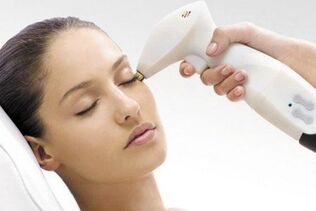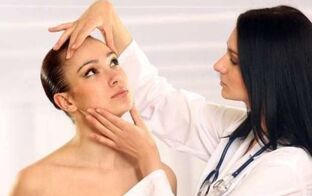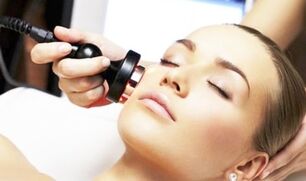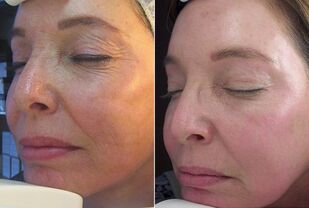For a long time, plastic surgery was the only way to rejuvenate. However, this method has many contraindications and is also associated with certain health risks, so not all of them can be solved with the help of surgery. Fortunately, modern aesthetic medicine offers many less dangerous anti-aging treatments. One of the decent alternatives to plastic surgery is laser facelift.
Fortunately, modern aesthetic medicine offers many less dangerous anti-aging treatments. One of the decent alternatives to plastic surgery is laser facelift.
What is this?
Laser lifting is a modern non-surgical way to combat age-related skin changes. This technique is aimed at improving the quality of the skin. Stimulates regenerative processes (cell renewal), improves blood circulation in the areas in contact with the laser, which helps to smooth wrinkles.
Natural collagen is produced during the procedure, which provides tissue elasticity. This is especially important for areas with sensitive skin where different rejuvenation methods are unacceptable.
The difference between laser lifting and other plastic and face lifting methods is that this procedure does not involve surgery. Special surgical equipment is used for laser therapy. The light beam penetrates the skin and affects weakened and dead cells.
Laser facelift can be done for women and men between the ages of 18 and 70. Often the need for this procedure arises after 30 years when the first signs of skin aging appear.
Generally, cosmetologists prescribe laser lifting courses because one session is not enough. Maximum effect is possible 3 months after the last procedure. With proper skin care, the rejuvenating effect can last for about three years.
Instructions for the procedure
Laser removal will help solve many problems. The procedure is indicated for patients with the following problems:

- sagging skin of eyelids;
- expression and age wrinkles;
- dark rings and bags under the eyes;
- pronounced nasolabial fold;
- acne scars;
- small scars;
- enlarged pores;
- unhealthy skin;
- presence of age spots;
- vascular networks;
- swinging double jaw;
- neck wrinkles.
Contraindications
Laser lifting is contraindicated due to the following factors:
- acute inflammatory and infectious diseases;
- any oncological disease;
- chronic diseases;
- various blood diseases;
- pregnancy and lactation;
- HIV infection;
- diabetes mellitus;
- mental disorders;
- diseases associated with the thyroid gland;
- epilepsy;
- hepatitis;
- skin diseases of any nature;
- poor blood clotting.
Types of skin coatings
Currently, two technologies are used in cosmetology practice: laser lifting: ablative and non-ablative. They differ in that each uses a different type of laser.
Ablat
Ablative is the most common laser lifting technology.The effects of light are directed to the outer layer of the epidermis, which is in constant contact with the environment.
Under the influence of the laser, the dead skin layers gradually evaporate. The ablative facelift is traumatic, but provides results.
Non-ablative
This technique involves a laser beam that penetrates deep into the skin and stimulates the synthesis of collagen and elastin. The top layer of skin remains intact. This laser lifting method helps to improve the tissue tone resulting in facial correction.
Unlike ablative fastening, also known as "burning", non-ablative technique is considered softer. The non-ablative lifting method is allowed to be used to affect sensitive skin areas - eyelids and around the eyes.
This technology is not very popular, because many cosmetologists doubt its effectiveness.
Prepare for the procedure
Before the laser lifting procedure, it is important to visit a cosmetologist who will assess the general condition of the skin and draw a conclusion about the appropriateness of the operation.To reduce the risk of side effects, you should take the following tests:
- General analysis of blood and urine;
- chest radiography;
- syphilis test;
- HIV test;
- cardiogram of the heart.
The doctor should be aware of all the diseases that the patient is exposed to.
About two weeks before the meeting, follow the simple rules:
- Refuse to visit the bath, sauna and solarium and do not sunbathe in the sun;
- Do not consume alcoholic beverages;
- Take antiviral drugs in one course (only as prescribed by a cosmetologist).
It is not recommended to drink coffee and energy drinks on the day of the meeting.
How is the facelift done?
The laser lifting method is relatively simple:

- To remove hair, the patient puts a medical cap or bandage over his head and lies down on the couch.
- Then the doctor prepares the skin: removes makeup residue and oily secretions.
- Then a cooling gel is applied to the face. Anesthetic creams are used for patients with very sensitive skin.
- The procedure is painful. For this reason, it is often performed under local or general anesthesia.
- The patient's eyes must be protected during the session, so they wear dark glasses. After completing the preparations, the laser lifting process can begin.
- The doctor uses a special device that manipulates the patient's face, paying special attention to the problem areas and working carefully.
Depending on the procedure used, different equipment is used. It differs in the technology of exposure and the depth of penetration of the light beam.
There are two types of lasers: cold and hot. A carbon dioxide, erbium or diode laser can be used to correct the face.
- The carbon dioxide laser is the most powerful. Helps get rid of any wrinkles & scars
- Erbium effectively fights the first signs of aging. Has a mild effect on the skin surface.
- Skin rejuvenation is carried out by means of a diode laser. The light beam can penetrate 5-50 mm.
Ablative rejuvenation is performed with a carbon dioxide laser. Under the influence of heat, dead cells gradually evaporate, leaving new and young skin.
Erbium and diode lasers are used to create a non-abrasive face.The movement of the light beam is directed to the inner layers of the skin. Collagen production processes are triggered in connective tissues and help tighten and rejuvenate the skin.
After the procedure, the cosmetologist treats the patient's face with antiseptic, then applies a soothing cream or mask.
Before and after photos
Additionally, you can see the result before and after the procedure in the photo.

Rehabilitation
The duration of the rehabilitation period depends on the technology of the procedure.The stronger the effect, the longer it takes for the skin to fully recover.
During rehabilitation, the skin becomes red, swollen and hypersensitive. These are the permissible results of laser lifting and should not be alarming. After a few days, the symptoms will disappear on their own.
After laser removal, the skin needs gentle care. The patient should strictly follow the doctor's recommendations and follow the following rules:
- Do not go to the pool, sauna, bath and beach for two to three months;
- Be sure to use sunscreen when you go out;
- Do not use decorative cosmetics until the skin is completely restored;
- Try to touch your face as little as possible with your hands;
- exclude facial massage;
- to give up bad habits;
- follow a healthy diet;
- Drink plenty of fluids.
With proper care and the advice of a cosmetologist, the results of compression can be seen after seven days. The skin becomes firmer and healthier, wrinkles and scars disappear. The plain of the face will have an even shape and clear contours. Changes are generally not visible immediately after the procedure.
Complications
Laser facelift is a safe way to rejuvenate. During the procedure, the skin does not come into direct contact with the equipment, so the risk of infection with various diseases is minimized. Complications can occur in two cases: insufficient professionalism of the cosmetologist and non-compliance with the rules of care of the patient.
The following side effects are the most dangerous:
- herpes;
- increased skin pigmentation;
- white dots;
- wound formation (in case of tearing of the formed shells).
























































